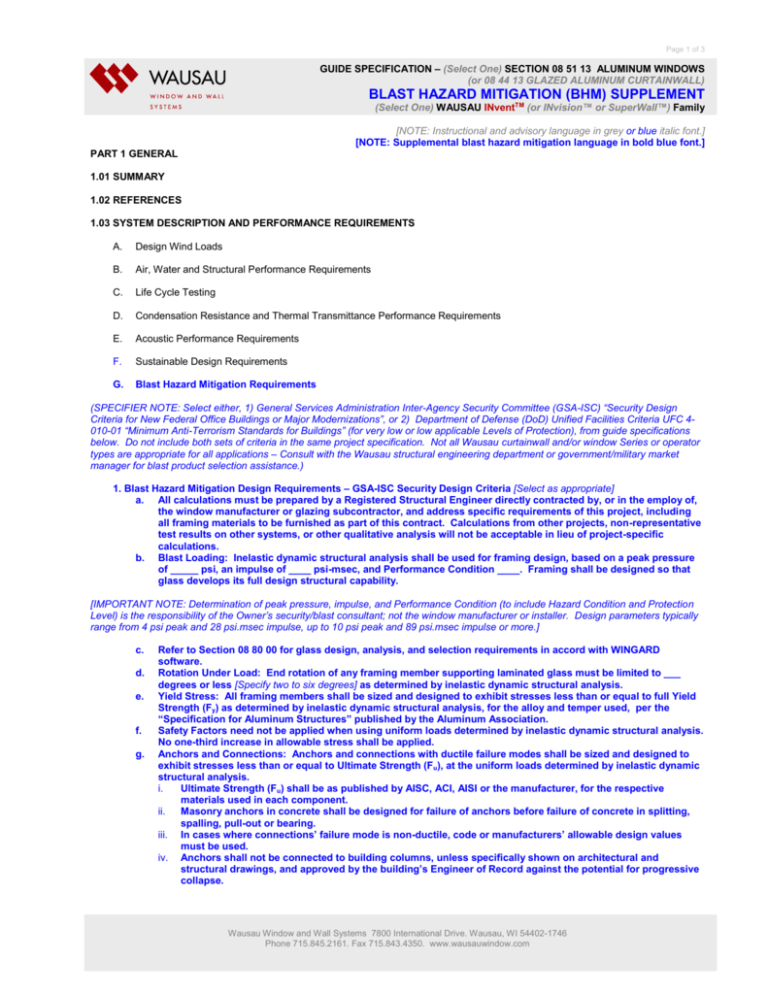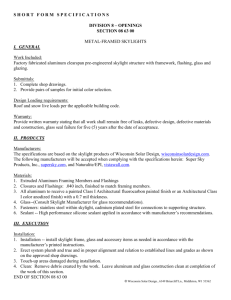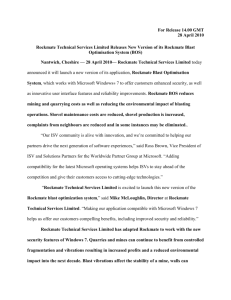
Page 1 of 3
GUIDE SPECIFICATION – (Select One) SECTION 08 51 13 ALUMINUM WINDOWS
(or 08 44 13 GLAZED ALUMINUM CURTAINWALL)
BLAST HAZARD MITIGATION (BHM) SUPPLEMENT
(Select One) WAUSAU INventTM (or INvision™ or SuperWall™) Family
[NOTE: Instructional and advisory language in grey or blue italic font.]
[NOTE: Supplemental blast hazard mitigation language in bold blue font.]
PART 1 GENERAL
1.01 SUMMARY
1.02 REFERENCES
1.03 SYSTEM DESCRIPTION AND PERFORMANCE REQUIREMENTS
A.
Design Wind Loads
B.
Air, Water and Structural Performance Requirements
C.
Life Cycle Testing
D.
Condensation Resistance and Thermal Transmittance Performance Requirements
E.
Acoustic Performance Requirements
F.
Sustainable Design Requirements
G.
Blast Hazard Mitigation Requirements
(SPECIFIER NOTE: Select either, 1) General Services Administration Inter-Agency Security Committee (GSA-ISC) “Security Design
Criteria for New Federal Office Buildings or Major Modernizations”, or 2) Department of Defense (DoD) Unified Facilities Criteria UFC 4010-01 “Minimum Anti-Terrorism Standards for Buildings” (for very low or low applicable Levels of Protection), from guide specifications
below. Do not include both sets of criteria in the same project specification. Not all Wausau curtainwall and/or window Series or operator
types are appropriate for all applications – Consult with the Wausau structural engineering department or government/military market
manager for blast product selection assistance.)
1. Blast Hazard Mitigation Design Requirements – GSA-ISC Security Design Criteria [Select as appropriate]
a. All calculations must be prepared by a Registered Structural Engineer directly contracted by, or in the employ of,
the window manufacturer or glazing subcontractor, and address specific requirements of this project, including
all framing materials to be furnished as part of this contract. Calculations from other projects, non-representative
test results on other systems, or other qualitative analysis will not be acceptable in lieu of project-specific
calculations.
b. Blast Loading: Inelastic dynamic structural analysis shall be used for framing design, based on a peak pressure
of _____ psi, an impulse of ____ psi-msec, and Performance Condition ____. Framing shall be designed so that
glass develops its full design structural capability.
[IMPORTANT NOTE: Determination of peak pressure, impulse, and Performance Condition (to include Hazard Condition and Protection
Level) is the responsibility of the Owner’s security/blast consultant; not the window manufacturer or installer. Design parameters typically
range from 4 psi peak and 28 psi.msec impulse, up to 10 psi peak and 89 psi.msec impulse or more.]
c.
d.
e.
f.
g.
Refer to Section 08 80 00 for glass design, analysis, and selection requirements in accord with WINGARD
software.
Rotation Under Load: End rotation of any framing member supporting laminated glass must be limited to ___
degrees or less [Specify two to six degrees] as determined by inelastic dynamic structural analysis.
Yield Stress: All framing members shall be sized and designed to exhibit stresses less than or equal to full Yield
Strength (Fy) as determined by inelastic dynamic structural analysis, for the alloy and temper used, per the
“Specification for Aluminum Structures” published by the Aluminum Association.
Safety Factors need not be applied when using uniform loads determined by inelastic dynamic structural analysis.
No one-third increase in allowable stress shall be applied.
Anchors and Connections: Anchors and connections with ductile failure modes shall be sized and designed to
exhibit stresses less than or equal to Ultimate Strength (Fu), at the uniform loads determined by inelastic dynamic
structural analysis.
i.
Ultimate Strength (Fu) shall be as published by AISC, ACI, AISI or the manufacturer, for the respective
materials used in each component.
ii.
Masonry anchors in concrete shall be designed for failure of anchors before failure of concrete in splitting,
spalling, pull-out or bearing.
iii. In cases where connections’ failure mode is non-ductile, code or manufacturers’ allowable design values
must be used.
iv. Anchors shall not be connected to building columns, unless specifically shown on architectural and
structural drawings, and approved by the building’s Engineer of Record against the potential for progressive
collapse.
Wausau Window and Wall Systems 7800 International Drive. Wausau, WI 54402-1746
Phone 715.845.2161. Fax 715.843.4350. www.wausauwindow.com
Page 2 of 3
h.
i.
j.
Welding: If welded connections are utilized at windows, sub-frames, or other connections, the weld shall never be
the weakest point through which loads are transferred back to the building structure.
Concrete and Masonry: The Owner, a designated representative, or the masonry anchor manufacturer shall
provide the curtainwall manufacturer’s Registered Structural Engineer with statistically valid survey data verifying
design strength of in-place concrete or other masonry substrates, including the lower limit of the confidence
interval to be used by the manufacturer in structural calculations.
Other Loads: In addition to blast loads, all components must be designed to satisfy applicable code requirements
for adequate glass support, wind, and gravity loads.
2. Blast Hazard Mitigation Design Requirements – DoD Unified Facilities Criteria [Select as appropriate]
a.
b.
c.
d.
e.
All calculations must be prepared by a Registered Structural Engineer directly contracted by, or in the employ of,
the manufacturer or glazing subcontractor, and address specific requirements of this project, including all
framing materials to be furnished as part of this contract. Calculations from other projects, non-representative
test results on other systems, or other qualitative analysis will not be acceptable in lieu of project-specific
calculations.
Blast Loading: A multiple of equivalent three-second duration design load, based on ASTM F 2248, shall be used
for framing and connection design, in accord with Department of Defense (DoD) Unified Facilities Criteria UFC 4010-01 “Minimum Anti-Terrorism Standards for Buildings” 9 February 2012, Change 1, 1 October 2013
Applicable Level of Protection shall be ___________. [Specify “Very Low” or “Low”]
Standoff Distance shall be ___ feet. [Specify distance – IMPORTANT NOTE: Standoff Distance must be greater than 43
feet for Charge Weight I, or 23 feet for Charge Weight II, otherwise this Wausau Guide Specification is inapplicable.]
Charge Weight ___ [Specify I or II]
(IMPORTANT NOTE: Determination of applicable Level of Protection, Stand-Off Distance and Charge Weight is the responsibility of the
Owner’s security/blast consultant; not the window manufacturer or installer.)
f.
g.
h.
i.
j.
k.
l.
m.
n.
Refer to Section 08 80 00 for glass design, analysis, and selection requirements in accord with DoD UFC 4-010-01,
ASTM F 2248 and ASTM E 1300.
Framing Deflection: Limit deflection of frame members, in a direction normal to the wall, to 1/60 of the supported
glazing edge dimension, at two times the glazing load resistance.
Glass Support: Comply with glass bite and structural silicone joint width requirements of DoD UFC 4-010-01.
For structural silicone glazed systems, joint width must be one to two times the thickness of the glass to which it
is adhered.
i.
For monolithic glass, structural silicone shall be applied to both faces.
ii.
For insulating glass units, structural silicone shall be applied to the inboard face.
For systems that do not utilize structural silicone:
i.
Provide glass bite no less than four times the inboard glass thickness, and
ii.
Provide dynamic analysis indicating adequacy of glass bite across the full range of unit size variation,
validated by shock tube or open arena testing at a laboratory accredited specifically for blast testing.
Project-specific calculations indicating adequacy of anchorage shall be provided. Static analysis of dry-glazed
systems shall not be permitted.
Connections and Anchors: All frame-to-frame connections and connections to the building, shall be designed
using ASTM F2248 under the assumption that the glazing must fail before the frame members and their
connections. To ensure this, connections shall be designed to at least the following levels:
i.
Two times the glass load resistance, if the maximum airblast pressure is greater than one-half the glass load
resistance, or
ii.
The glass load resistance, if the maximum airblast pressure is less than one-half the glass load resistance.
iii. Allowable stresses shall be as published by AISC, ACI, AISI or the manufacturer, for the respective materials
used in each component.
iv. Geometry and connection configuration shall be taken into account in calculation of loads on connections
and anchors.
Other Loads: In addition to blast loads, all components must be designed to satisfy applicable code requirements
for adequate glass support, wind and gravity loads.
Shock tube or open arena testing, at a laboratory accredited specifically for blast testing, may be acceptable in
lieu of static or dynamic analysis, if sizes and configurations tested comply fully with the limitations of
USACE/NAVFAC/AFCESA/NASA UFGS-08 51 13 “Unified Facilities Guide Specification.”
1.04 SUBMITTALS
A.
General Requirements
B.
Shop Drawings
C.
Samples
D.
Test Reports and Calculations
1. Submit certified independent laboratory test reports if used in lieu of, or in addition to, static and/or dynamic analysis
required in 1.03.G for confirmation of blast hazard mitigation performance.
2. Submit structural calculations indicating adequacy of all materials furnished under this section, to meet the uniform and
structural load requirements as specified in 1.03.
1.05 QUALITY ASSURANCE
Wausau Window and Wall Systems 7800 International Drive. Wausau, WI 54402-1746
Phone 715.845.2161. Fax 715.843.4350. www.wausauwindow.com
Page 3 of 3
1.06 DELIVERY, STORAGE AND HANDLING
1.07 WARRANTY
PART 2 PRODUCTS
2.01 MANUFACTURERS
2.02 MATERIALS
2.03 COMPONENTS
A.
Hardware (Select from options as noted)
1. All steel components including attachment fasteners to be stainless steel, except as noted.
2. Extruded aluminum components 6063-T5 or -T6.
3. Locking handles, bases and strikes to be die-cast, white bronze or stainless steel in manufacturer’s standard surface finish.
4. Thermo-plastic or thermo-set plastic caps, housings and other components to be injection-molded nylon, extruded PVC or other
suitable compound.
5. Hardware components must meet the blast hazard mitigation requirements of 1.03.G and include: (Select from
appropriate options listed in the Wausau Hardware Selection Guide: stainless steel four-bar hinges, extruded aluminum butt
hinges, linear operation keepers, single-handle Euro multi-lock, roto-operators, concealed friction adjusters and concealed
limited opening devices.)
2.04 FABRICATION
2.05 FINISHES
PART 3 EXECUTION
3.01 EXAMINATION
3.02 INSTALLATION
A.
Erection of Aluminum Windows
1. Install all windows with skilled workers in accordance with approved shop drawings, installation instructions, specifications and
the “AAMA Commercial Window and Door Installation Manual.”
2. Vent windows must be installed -- and must remain -- plumb, square and level, to one-half of the unit shimming tolerances cited
in the “AAMA Commercial Window and Door Installation Manual,” for proper weathering and operation.
3. Blast hazard mitigating window and curtainwall systems will require engineered supplemental anchorage to achieve
compliance with 1.03.G.
4. Aluminum that is not organically coated shall be insulated from direct contact with steel, masonry, concrete or other dissimilar
metals by bituminous paint, rust-inhibiting primer, non-conductive shims or other suitable insulating material.
DISCLAIMERS:
Wausau Window and Wall Systems takes no responsibility for product selection or application, including, but not limited to, compliance
with building codes, safety codes, laws, merchantability or fitness for a particular purpose; and further disclaims all liability for the use, in
whole or in part, of these Guide Specifications in preparation of project specifications and/or other documents. Guide Specifications are
subject to change at any time, without notice, and at Wausau’s sole discretion.
“INvent,” “INvision” and “SuperWall” are trademarks of Apogee Wausau Group, Inc. All rights reserved. ©2014 Apogee Wausau Group,
Inc.
Wausau Window and Wall Systems 7800 International Drive. Wausau, WI 54402-1746
Phone 715.845.2161. Fax 715.843.4350. www.wausauwindow.com








